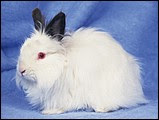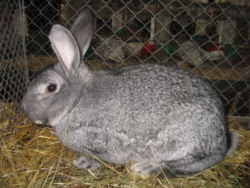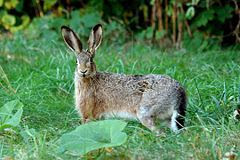
Diet and eating habits
Rabbits are herbivores who feed by grazing on grass, forbs, and leafy weeds. In addition, their diet contains large amounts of cellulose, which is hard to digest. Rabbits solve this problem by passing two distinctive types of feces: hard droppings and soft black viscous pellets, the latter of which are immediately eaten. Rabbits reingest their own droppings (rather than chewing the cud as do cows and many other herbivores) in order to fully digest their food and extract sufficient nutrients. [5] [6]
Rabbits graze heavily and rapidly for roughly the first half hour of a grazing period (usually in the late afternoon), followed by about half an hour of more selective feeding. In this time, the rabbit will also excrete many hard faecal pellets, being waste pellets that will not be reingested. If the environment is relatively non-threatening, the rabbit will remain outdoors for many hours, grazing at intervals. While out of the burrow, the rabbit will occasionally reingest its soft, partially digested pellets; this is rarely observed, since the pellets are reingested as they are produced. Reingestion is most common within the burrow between 8 o'clock in the morning and 5 o'clock in the evening, being carried out intermittently within that period.
Hard pellets are made up of hay-like fragments of plant cuticle and stalk, being the final waste product after redigestion of soft pellets. These are only released outside the burrow and are not reingested. Soft pellets are usually produced several hours after grazing, after the hard pellets have all been excreted. They are made up of micro-organisms and undigested plant cell walls.
The chewed plant material collects in the large cecum, a secondary chamber between the large and small intestine containing large quantities of symbiotic bacteria that aid in the digestion of cellulose and also produce certain B vitamins. The pellets are about 56% bacteria by dry weight, largely accounting for the pellets being 24.4% protein on average. These pellets remain intact for up to six hours in the stomach, the bacteria within continuing to digest the plant carbohydrates. The soft feces form here and contain up to five times the vitamins of hard feces. After being excreted, they are eaten whole by the rabbit and redigested in a special part of the stomach. This double-digestion process enables rabbits to utilize nutrients that they may have missed during the first passage through the gut and thus ensures that maximum nutrition is derived from the food they eat. [1] This process serves the same purpose within the rabbit as rumination does in cattle and sheep. [7]
Rabbits are incapable of vomiting due to the physiology of their digestive system.[8]
Rabbits are herbivores who feed by grazing on grass, forbs, and leafy weeds. In addition, their diet contains large amounts of cellulose, which is hard to digest. Rabbits solve this problem by passing two distinctive types of feces: hard droppings and soft black viscous pellets, the latter of which are immediately eaten. Rabbits reingest their own droppings (rather than chewing the cud as do cows and many other herbivores) in order to fully digest their food and extract sufficient nutrients. [5] [6]
Rabbits graze heavily and rapidly for roughly the first half hour of a grazing period (usually in the late afternoon), followed by about half an hour of more selective feeding. In this time, the rabbit will also excrete many hard faecal pellets, being waste pellets that will not be reingested. If the environment is relatively non-threatening, the rabbit will remain outdoors for many hours, grazing at intervals. While out of the burrow, the rabbit will occasionally reingest its soft, partially digested pellets; this is rarely observed, since the pellets are reingested as they are produced. Reingestion is most common within the burrow between 8 o'clock in the morning and 5 o'clock in the evening, being carried out intermittently within that period.
Hard pellets are made up of hay-like fragments of plant cuticle and stalk, being the final waste product after redigestion of soft pellets. These are only released outside the burrow and are not reingested. Soft pellets are usually produced several hours after grazing, after the hard pellets have all been excreted. They are made up of micro-organisms and undigested plant cell walls.
The chewed plant material collects in the large cecum, a secondary chamber between the large and small intestine containing large quantities of symbiotic bacteria that aid in the digestion of cellulose and also produce certain B vitamins. The pellets are about 56% bacteria by dry weight, largely accounting for the pellets being 24.4% protein on average. These pellets remain intact for up to six hours in the stomach, the bacteria within continuing to digest the plant carbohydrates. The soft feces form here and contain up to five times the vitamins of hard feces. After being excreted, they are eaten whole by the rabbit and redigested in a special part of the stomach. This double-digestion process enables rabbits to utilize nutrients that they may have missed during the first passage through the gut and thus ensures that maximum nutrition is derived from the food they eat. [1] This process serves the same purpose within the rabbit as rumination does in cattle and sheep. [7]
Rabbits are incapable of vomiting due to the physiology of their digestive system.[8]



















